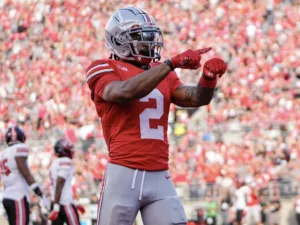
Can College Yards After Catch Help Predict NFL Success For Wide Receivers?
For our 61 part “Does It Matter?” series, we looked into whether a Wide Receiver’s College Yards After Catch per Reception (YAC/Rec)
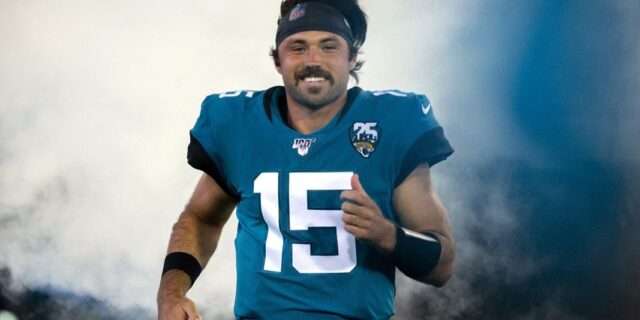
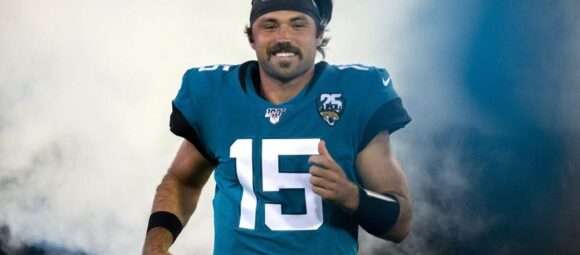
In the latest installment of our “Does It Matter?” series we dove deep into the analytics of NFL quarterbacks to verify a theory or prove it to be a myth: Does hand size truly matter for a quarterback’s performance? After rigorous number-crunching, we are excited to report that our research has revealed an extremely eye-opening trend. Further, we identified two promising players who exhibit traits reminiscent of legends like Peyton Manning, Josh Allen, and more within a very high success rate group that we found.
First, we created a list of the top 30 fantasy football finishers since 2003. We wanted to ensure the highest accuracy and consistency in our data. Therefore, due to initial learning curve that rookies often face, we excluded all rookie quarterbacks from these lists. Our data was exclusively sourced from NFL Draft Combine numbers. This standardized our measurements and we further rounded hand lengths to the nearest 1/8 inch for more coherent charts.
Our research then led us to calculating the average hand sizes of the top 5, 10, 11-20th, and 21-30th place finishers since 2003. Analyzing this chart revealed small patterns: quarterbacks in the top 5 consistently showcased hand sizes between 9.5 and 9.9 inches. Furthermore, the top 10 finishers’ hand sizes hovered between 9.6 and 9.8 inches. This indicates a clear correlation between larger hand sizes and superior performance. This higher performance can also be seen by looking at the blue (top 10) line fairly consistently hovering above the green (11th-20th) and purple (21st-30th) line. Mainly between 2011 to 2021.
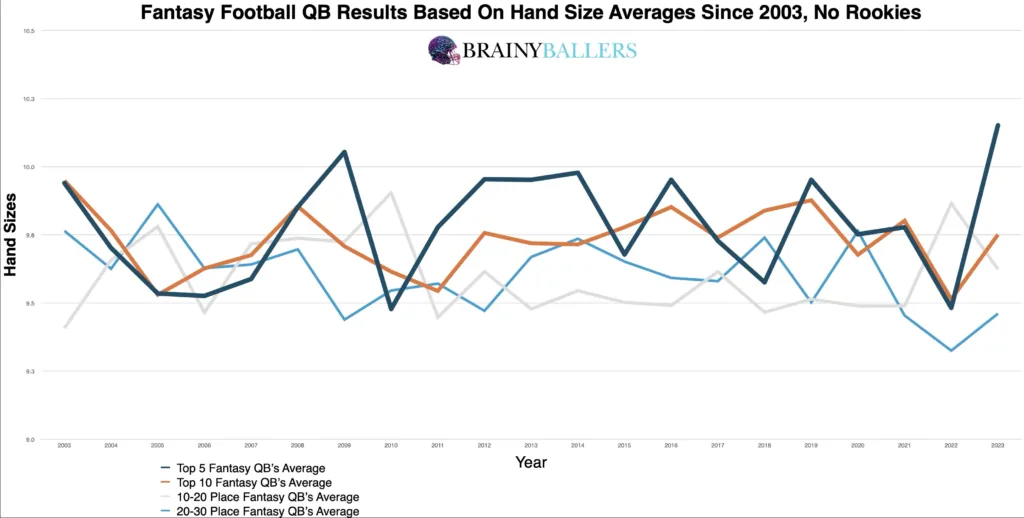
However, it was our incremental analysis that began unraveling something big. We charted every top 5 finisher since 2003 in .05 inch increments and contrasted them with the bottom 5. From this, we discovered a notable increase in hand sizes ranging from 9.4 to 9.65 inches as performance improved. The Top 5 and Bottom 5 chart can be seen below:
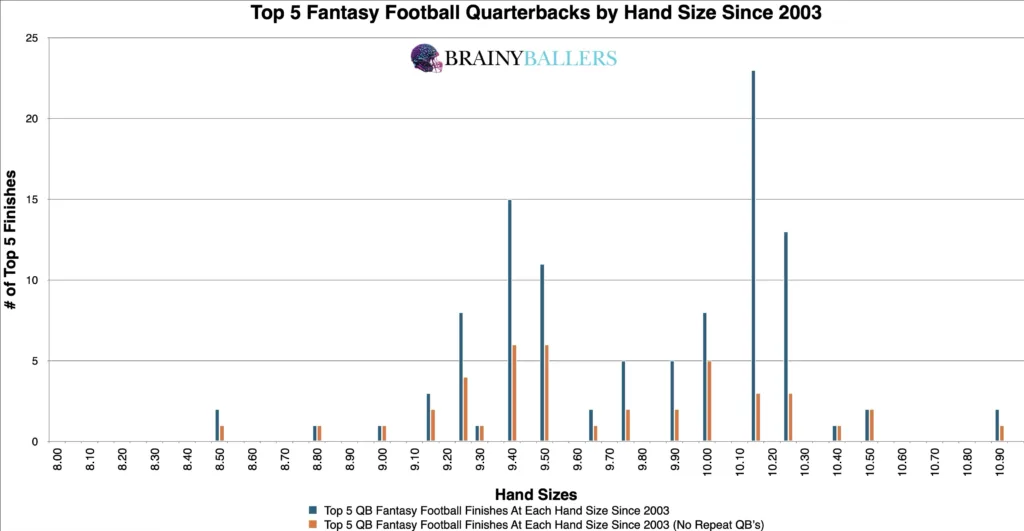
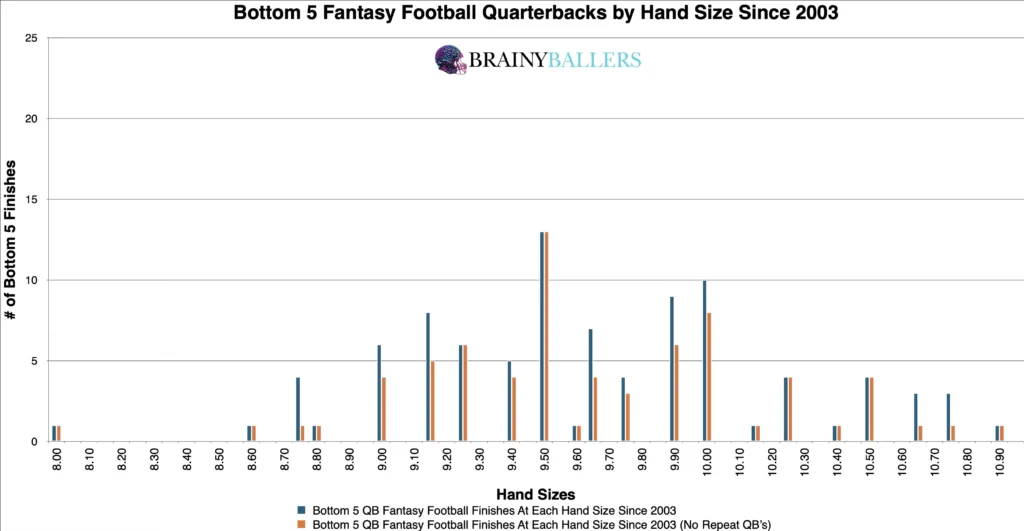
Yet, the most staggering revelation emerged in the 10.15 to 10.4 inch (10-1/8” to 10-3/8” before rounding) range, where a significant spike in nfl quarterback performance occurred. To validate this range’s impact, we created a difference chart comparing the top 5 finishers for each hand length plus the next 1/4” against the bottom 5. This showcased an unprecedented finding as seen below:
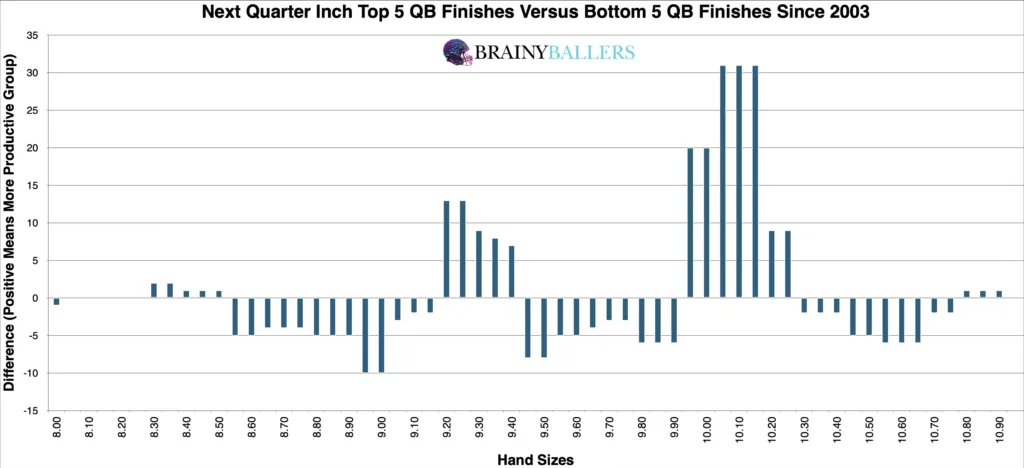
This best 1/4” range can be visualized in the chart. To explain this chart, each bar shows a difference between the top 5 and bottom 5 plus the next 1/4” starting at the bars allocated hand size. At 10.05, the graph shows its largest value, indicating the next 1/4” will reach its peak. Since the next higher 1/8” increment would be 10.15 (10-1/8” before rounding), we simply went to 10.15 (10-1/8”) and noticed the bar remains the same as the 10.05 peak. This is therefore further verifying the 1/4” bracket.
We wanted to compare the percentage of Top 5 QB’s who fell within this Hand size range and the average after the top 5. There were 465 quarterbacks who finished between 6-30 since 2003 with Hand size measurements taken. The findings revealed that 99 quarterbacks, or 21.3%, fell within this defined range. This statistic served as a baseline for further comparison against the top 5 quarterbacks over the same time period. Astonishingly, of the 103 quarterbacks who finished in the top 5, 37 fell within this Hand size range. This equated to 36%, a near 15% increase over the baseline! This further indicated a trend.
For standard statistical methods, we calculated a Pearson Value of 0.076. This indicates no significant correlation between a QB’s hand size and fantasy performance. We are hoping for a minimum of 0.1, or an inverse correlation maximum of -0.1 when we study world-class athletes as we are. For reference to something that everyone acknowledges matters in prospect scouting, and to show the accompanying Pearson value, RB draft capital prevailed a -0.234 Pearson value.
To understand the evolution of this trend, we further segmented the data into two decades: 2004-2013 and 2014-2023. The earlier decade showed a staggering 44.9% of the top 5 quarterbacks falling within the specified hand size range. Further, there was a significant drop as the ranking lowers. With 12.5% and 9% in the 6-25th and bottom 5 finishers, respectively. The latter decade showed a decrease across all categories but maintained the overall trend. With the top 5 finishers at 28%, 6-25th at 9%, and the bottom 5 at 2%. This decadal comparison underscores a clear pattern: quarterbacks with hand sizes within the targeted range are closer to the top tier.
Hand Sizes could play a small factor in our Star-Predictor Score (SPS) model. The Star-Predictor Score (SPS) is a scouting tool designed to maximize investment potential and reduce risks when drafting rookies in Fantasy Football. It is proven to have a higher accuracy than draft capital alone to predict fantasy success. The SPS includes 13 to 17 metrics, with the exact number varying by the player’s position. All these metrics are pre-NFL, and some are invented by us, providing a complete analysis of a player’s analytical profiles. The SPS gained widespread notoriety for its high accuracy, having made it on Barstool and The Pat McAfee Show. The SPS can be found here.

Expanding our research, we were asked to explore the instances of quarterbacks who succeeded despite having historically smaller height and weights. Focusing on Drew Brees and Russell Wilson since they were widely known as small. Remarkably, both athletes boast hand lengths of 10.25 inches, positioning them dead center of our study’s focused hand size range! This discovery supports the hypothesis that quarterbacks with this specific hand size can achieve extraordinary success in the NFL. Further, Hand size perhaps is much more important than height and weight.
We wanted to test a theory using our newfound Hand Size range, Height range we found last week, and Weight range we found 2 weeks ago. All while using the data we compiled from the top 30 fantasy football quarterbacks each year since 2003.
We wanted to see which players across all thresholds (1st-30th place, years 2003-2023) fell within our ranges for hand size, weight, and height. Although, after the Brees and Wilson revelation it was clear that hand size could be more important than weight/height. Therefore, we found every player across the 588 players in our list with this criteria: within our height range sweet spot OR within our weight range sweet spot AND within the hand size sweet spot we just found. Essentially, the Hand size range is required to qualify for this list. After that, players needed to be within either the height range or weight range to qualify for this list. No player fell within all 3 ranges. The results were far more revealing than we initially anticipated:
Quarterbacks Matching the Criteria:
Notably, 7 out of these 8 quarterbacks achieved at least one top 10 finish in their career in fantasy football. Further, six out of eight managed to secure at least one top 5 finish. The one who didn’t score the top 10 finish is Gardner Minshew. Minshew, who is the one this list needs to go 8 for 8 in top 10 finishes, is currently competing for a starting spot on the Las Vegas Raiders (*wink wink*).
An intriguing part of our research points towards the up-and-coming talents. Joe Milton, a 2024 rookie does not only match the ideal hand size but also the height sweet spot. This places him in a promising position. Looking at his current 2024 NFL Draft projection, he could start drawing comparisons to quarterbacks like Dak Prescott. Prescott was selected in round 4, while Milton is projected between rounds 5-6. If Milton is drafted to a team without a franchise QB established, you absolutely should pursue him in fantasy football. This also gives further vindication to us having him as a fantasy football buy this year.
What 3 metrics matter the most when scouting a rookie Quarterback? What threshold should Quarterbacks achieve within those metrics to be considered an elite prospect? How much should you value those stats above all other stats? Couldn't answer those questions? Rest easy, we have it handled for you. That's what this chart answers. Sort by importance and/or filter by position. Unlock by signing up with the links provided. $9.99/Year or $24.99 Lifetime access. Cancel anytime.
The exhaustive research undertaken for Part 3 of our “Does It Matter?” series has not only shed light on an often overlooked aspect of quarterback evaluation but also highlighted the importance of embracing analytics in understanding the intricate dynamics of NFL success. The intriguing alignment of Drew Brees and Russell Wilson within the optimal hand size range exemplifies the potential for quarterbacks with similar attributes to excel. Hand size plays a more significant role in determining quarterback performance than previously acknowledged. Further, with the perfect Hand size falling between 10-1/8” and 10-3/8”.
Stay tuned for our weekly data-driven explorations which will be released every Saturday. We will dive deep into the world’s most intriguing questions, bust myths, and settle debates with thorough analysis similar to this. We thrive on curiosity and welcome your input—so please, leave comments or reach out to us with topics you’re eager to see dissected next. All of our research can be found on our Analytics Page. Up next on our agenda for Part 4 of “Does It Matter?” is an examination of Wide Receiver Heights: Does that impact performance? If so, what’s the ideal height for a WR? Your insights and questions fuel our research, so join us in this analytical journey. Mark your calendars; every Saturday we shed light on the topics that matter to you. All it takes is a short question and we will go to work for you!



For our 61 part “Does It Matter?” series, we looked into whether a Wide Receiver’s College Yards After Catch per Reception (YAC/Rec)
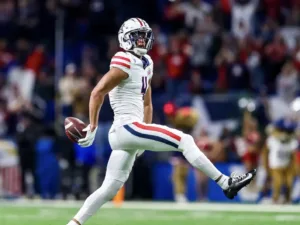
In part 60 of our “Does It Matter?” series, we dove into the question of whether a college Wide Receiver’s career Average
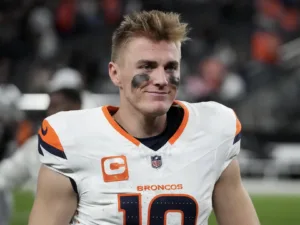
The “Does It Matter?” series, part 59 looked to uncover the role of a quarterback’s rookie touchdown per game (TD/G) in predicting
© 2023 BrainyBallers | All Rights Reserved